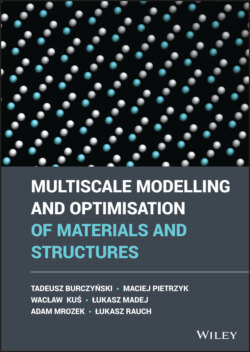Читать книгу Multiscale Modelling and Optimisation of Materials and Structures - Tadeusz Burczynski - Страница 16
1.3 Contents of the Book
ОглавлениеThe aspects of multiscale modelling mentioned previously have already been discussed in numerous publications, including several books [4, 12, 13, 15]. However, multiscale modelling still remains a difficult task, and its valid and reliable application is quite difficult. Moreover, the lack of an unambiguous definition leads to misunderstandings and mistakes. The book supplies some practical information concerning the development and application of multiscale material models, in particular in combination with optimization techniques.
As mentioned, the book is divided into three main sections. The first section is composed of Chapters 2 and 3, and it is focused on discussion of phenomena occurring in materials in processing and on models used to describe these phenomena. Such phenomena as recrystallization, phase transformations, cracking, fatigue, and creep are discussed very briefly. The modelling methods are divided into two groups. The first includes computational methods for continuum such as FEM, XFEM, and BEM. Discrete methods describing microscale and nanoscale phenomena include MS as well as MD, CA, and MC approaches. Computational homogenization methods, which are used in the coupled multiscale models, are also discussed in this part of the book. Basic principles of methods of optimization are also described in this part of the book, with a particular emphasis on the methods inspired by nature.
The second section of the book is composed of Chapters 4 and 5 and focuses on DMR. Case studies based on DMR are presented. Applications of methods described in Chapters 2 and 3 to modelling various processes and phenomena are shown.
The third section of the book is connected with applications of multiscale optimization methods. Such issues as optimization of atomic clusters, material parameters optimization, shape optimization, and topological optimization are discussed. The problem of identification in multiscale modelling is also presented.
Computer implementation issues for multiscale models are recapitulated in the book. Implementation of selected algorithms concerning visualization as well as scales coupling with use of commercial software are described in Chapter 7. The part will highlight the possibilities of increasing the computational efficiency, which is especially important when optimization based on a direct problem model of multiscale nature is considered.
